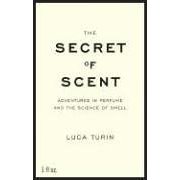Over Christmas I have been reading Luca Turin’s book “The Science of Scent”. This became a real eye-opener for me with regards to my understanding of how the sense of smell works. (BTW, Luca Turin was also featured in Chandler Burr’s book “The Emperor of Scent” which I haven’t read yet).

The first part of the book includes a lot of basic chemistry (which can be skipped if you’re familiar with chemistry) plus descriptions of many perfumes and perfume ingredients which made we wish the book came with it’s own smelling strips. But then comes the interesting part. I have always thought of smell to be a result of molecular recognition – a typical interaction between a drug and a receptor or and enzyme and a substrate. The reason I guess is that this seems very intuitive – just like a shape sorter toy for children! I had also read a review article on “Structure-Odor Relationships” (Rossiter, K. J. Chem. Rev. 1996, 3201). Now the interesting thing is that this might be wrong (or at least not the whole truth – and scientific controversy is always exciting)!

Luca Turin suggests that it is the molecular vibrations of a molecule that we recognize as it’s smell. In an easy accesible article on this (at least for chemists), Turin puts up pro’s and con’s for both theories, including the following:
A very recent review entitled “The Nose as a Stereochemist. Enantiomers and Odor” (Bentley, R. Chem. Rev. 2006, 4099.) mentions Turins work, but with a short dismisal:
… a theory by L. Turin proposes inelastic electron tunneling to account for the biological transduction of molecular vibrations.[35][36] Recent experiments to test predictions of the theory found no evidence to support it [37]…
Reference 35 and 36 can be downloaded from www.flexitral.com – the latter needs to be saved/renamed as a pdf before opening. The contents of 37 is described here. It’s surprising however that Bentley uses ref 37 to disprove the vibration theory, because the authors refer to their own work as “… a paper of solely negative results”. What they did was to perform experiments, partly outlined in Turin’s book, that suggest that molecular vibrations alone cannot explain all aspects of smell. Despite the controversy, Luca Turin and his company Flexitral have been quite succesful in designing new odorants, especially stable odorants which imitate other, less stable molecules. The development of these new odorants is based on designing stable molecules with vibrations similar of the molecule it’s supposed to imitate.
But the story doesn’t end here: Very recently, physicists at University College London reported that they have discovered a physical mechanism that would allow a receptor to distinguish different molecular vibrations (read press release, preprint and SciAm news report). Put simple, the researchers have shown that when a molecule with the correct vibration binds to a receptor, a switch closes allowing electrons to flow. This means that there is experimental theoretical evidence that supports the vibration theory!
Now what does all this have to do with molecular gastronomy and food? When we talk about taste, it’s actually 80% aroma and 20% taste (more on this page). And with aroma, we’re talking about the smell of volatile molecules. Luca Turin touches upon this on the very last pages of the book were he writes that “An area which, in my opinion, is ripe for revolution is that of flavours”. Perhaps it will be possible one day to “synthesize” any desired odor (or aroma!) with a set of molecules (or condiments) with different molecular vibrations?

Thanks for the article ! One small correction: the recent work of Marshall Stoneham and colleagues at UCL, soon to be published in Physical Review Letters is theoretical rather than experimental. What they have shown is that subject to reasonable physical assumptions, electron tunneling within a protein can be coupled to the molecular vibrations of a bound odorant sufficiently strongly to make my original, far sketchier suggestion plausible. And one more thing: Flexitral has already designed three FEMA-approved synthetic flavor molecules. One of them, Acitral B, is an acid-stable lemon and is nearing production.
Another recent contribution that may be relevant is a paper by C. S. Sell: “On the Unpredictability of Odor” in Angew. Chem. 2006, 45, 6254-6261.
Abstract:
The relationship between molecular structure and odor has fascinated and puzzled chemists for more than a century. Despite a great deal of research on structure-odor relationships, prediction of the odor of a novel molecule remains a statistical exercise and models only provide a probability of the character, threshold, and intensity. Surprises are still commonplace, and serendipity continues to be an important factor in the discovery of novel fragrant molecules. Recent advances in our understanding of the mechanism of olfaction provide an explanation for this and suggest that our ability to predict odor properties of molecules will not improve significantly in the near future.
Ref.: http://www3.interscience.wiley.com/cgi-bin/abstract/113314071/ABSTRACT (need subscription to read full paper)
The point is not weather a single theory is the whole truth, but if a new theory can contribute to the understanding of an effect: Bohrs model of the atoms is severely flawed by todays standards, yet in its time and up to a certain level of understanding even today, it provides valuable insight into phenomenae that would otherwise be inaccessible and/or incomprehensible. Thus if the vibration based theory leads to flavours as stated above by Luca Turin, i.e. can be used to gain further insight, it can’t be all that wrong.
I remember reading some where of a company that manufactured an e-nose device (“electronic nose”) that used viberation to “smell” the molcules in the air.
they where intending it for milatry and police use, as a replacment for dogs.
Are you thinking of this work?
Although there’s vibrations involved, it’s not the vibrations of the volatile molecules that are measured. Rather it’s a combination of their molecular weight and their affinity to the different metalloporphyrins that defines the vibration frequency of the coated quartz crystals.